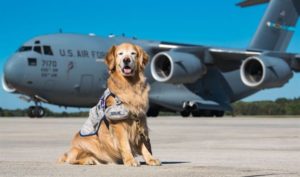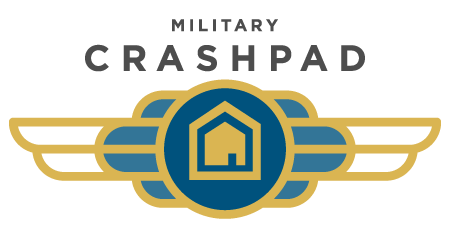Written by Dawn M. Smith exclusively for Military Crashpad®
Military families are often faced with difficult choices when it comes to a PCS with a pet, particularly overseas. They can either chose to ship their pet on their own dime and deal with the anxiety that comes with an airplane ride, or they can separate the family for a duration of time because the process of transporting the animal is too difficult. Neither of these circumstances is ideal when a pet is considered a family member.
As of late, the news cycles have been filled with horror stories of pet transport gone wrong. From overhead bin deaths to incorrect global destinations, our dogs and cats are suffering. By taking the time to research preventive measures for all modes of transportation we can try to mitigate the complications.
Veterinarian Recommendations for All Types of Travel
Because pet travel is so stressful not only on the pet but the owners too, its best to start by covering the safety basics for any type of travel. Scheduling an appointment with your veterinarian is the optimal place to start, but this list of must-dos provided by the American Veterinary Medical Association will get you started.
Contact Information
- Your personal veterinarian’s information
- A list of 24-hour veterinarian emergency hospitals near your destination
- National Animal Poison Control phone number 888-426-4435
Pet Identification
- Identification tag with owner’s name and current and reachable phone number
- Color photo of your pet
- Hotel/lodging information
- Updated microchip registration
Medical Information
- A copy of medical records including necessary medications
- Certificate of Veterinary Inspection (health certificate)
- Proof of vaccinations
- Some airlines require an acclimation certificate for air travel
- Medicines and monthly prescriptions
Comfort Items
- Leash and collar
- Appropriately sized and quality constructed crate
- Toys, bed, and blankets
- Food and water
- Pet first aid kit
Safety Tips for Dog and Cat Air Travel
Securing safe air travel is an arduous process. Researching flights, airline rules for pet travel, and collecting paperwork is just the beginning. Overseas flights require permission and accurate veterinary records from both the U.S. and incoming country.
To ensure continuity, strictly follow the military’s outgoing travel office’s directions. If your pet is of authorized size, always fly with it in a carrier in the main cabin. But, if cargo is the only way to travel, The Humane Society does offer some of their own advice for flying.
- Avoid multi-leg flights. There is more opportunity for handling mistakes.
- Book yourself on the same flight as your pet and ask to watch the animal load and unload.
- Use a collar that is not too snug or too loose and attach two forms of identification including names and phone numbers of contact.
- Affix a travel label to the crate with your name, permanent address, and telephone number, final destination, and how to make contact as soon as the flight arrives.
- Comfortably cut the pet’s nails so they do not get caught in holes or crevices of the crate.
- Introduce the carrier crate to the pet at least one month in advance.
- Do not use sedatives unless prescribed by your veterinarian.
- A small amount of water is recommended but avoid full meals.
Each airline has their own policies regarding the breeds they will transport. Some will not allow for snub-nosed (brachycephalic dogs such as Pekingese, Bulldogs, or Persian cats) animals to fly. In addition, airlines restrict the months of travel to avoid temperature extremes. Familiarize yourself with each detail of their policies and processes to ensure a safe journey for your pet.
Pet Relocation Companies
Pet relocation companies are fast becoming another amenity a pet owner can’t live without. In order to avoid any mix-ups in travel, with custom’s paperwork, transfer, or illness, pet relocation companies act as a concierge for your animal, managing all of their travel itineraries. Although the pet does fly in commercial cargo, this portion of your domestic and overseas PCS can be handled by professionals dedicated to the care and transport of your pet.
- Continental Pet Relocation
- Happy Tails Travel
U.S. Army Pfc. Jennifer Myrick, from Acworth, Ga., pets Dingo the dog at Camp As Sayliyah, Qatar, Aug 2. The world-traveling canine is becoming an icon for pet care and adoption. “Dingo is amazing,” said Myrick. “Animals are a big part of my life. I have a dog and four cats; all are adopted. I miss my pets more than anything. You can talk to your family on the phone but not your pets.” (Official Army Photo by Dustin Senger)
Alternatives to Commercial Airlines
Driving is usually the best bet to transfer your pet, especially if you can find a Military Crashpad®® that accepts pets for your PCS lodging.
Amtrak has recently renegotiated their pet policy and now offers more itineraries than ever for pet riders. Small cats and dogs are allowed to ride with passengers on select trains. For $25, pets who weigh 20 pounds or less (including their carrier) may travel for up to seven hours on many routes. Owners are responsible for their care during train stops. Amtrak does restrict pets to five per train, so they encourage riders to make reservations early.
Pet Airways is about to take off and offer non-cargo pet transportation. The company is a full-service airline solely dedicated to the transportation of pets in the cabin with regulated temperatures and air quality. Pet attendants routinely check all passengers to ensure comfort and safety. Keep an eye out for their upcoming routes and reservations.
The Air Force’s Air Mobility Command offers a thorough Pet Brochure that includes everything pet owners need to know to fly their animals on military flights to Europe known as the Patriot Express. These flights are very limited in how many pets are allowed on board.
Pets are accounted for as pieces of luggage and fees are charged on a per kennel basis. Depending on the combined weight of your pet and kennel, according to the brochure, fees vary from $125 to $375. Two airports offer these flights: Baltimore Washington International Thurgood Marshall Airport and Seattle-Tacoma International Airport.
As your travel plans approach, it’s important to become completely informed of all necessary precautions to protect your animal during its transport, whether in the air, car, or train. Specifically, know all of the rules and regulations to ship your pet on an airplane, especially overseas, otherwise, the chance of mishap becomes more likely.







